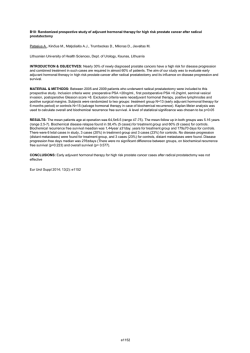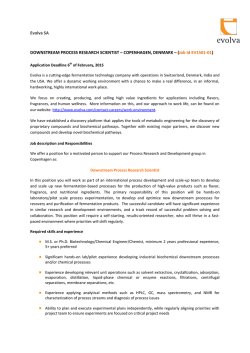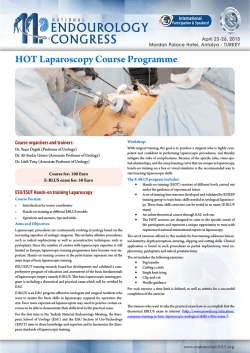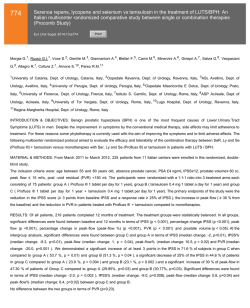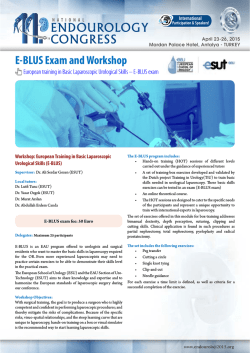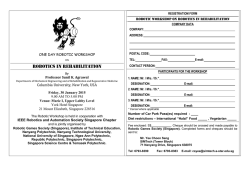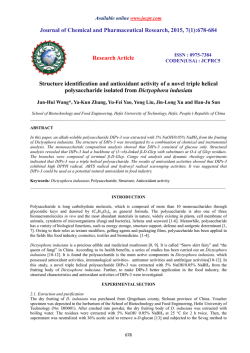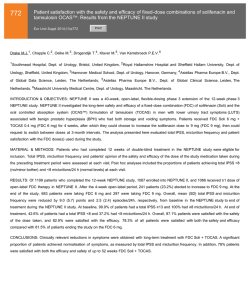
1-s2.0-S1569905614500760-main
U N M O D E R A T E D P O S T E R P R E S E N T A T I O N S / E U R O P E A N U R O L O G Y S U P P L E M E N T S 13 (2014) 1—60 quired 2 to 10 pads inclusive per day (PPD) – were eligible for 1:1 randomization ratio to either 5 mg SS daily or placebo. Randomized patients kept the SPH for another 12 weeks and answered daily inquiries, such as the number of PPD used over the prior 24 hours. The primary endpoint was the time interval from randomization to continence – defined as 0 pads use or a security pad completely dry for 3 consecutive days. Average PPD change from baseline to each visit was a secondary endpoint and the number of patients who reached 0–1 PPD use on any day of study was also analyzed as a post-hoc analysis. Results: Of the 1125 screened patients, 1086 had SPH data and 837 (77.1%) wore one or less PPD by 15 weeks after RALP. 640 patients met randomization criteria and 622 patients had complete post-baseline SPH data. There was no significant difference in the continence time interval – primary endpoint (p=0.17). Mean change from baseline to end of treatment in average daily pad use was −2.9 and −3.2, for placebo and SS, respectively (p=0.033). By study end, 202/309 (65.4%) in placebo and 233/313 (74.4%) in SS reported 0–1 PPD use (p=0.0137). Dry mouth was the onlycommon adverse event: 0.6% and 6.1% of placebo and SS, respectively. Conclusions: Solifenacin succinate did not significantly affect time to continence following RALP, but was significantly associated with reaching the 0–1 PPD milestone by the end of the study. Among 1086 screened subjects with SPH data 77% reach the 0–1 PPD milestone 15 weeks after RALP (Level 1–B evidence). PE43 Tablet based image guided robotic surgery – first in man A. Gavazzi 1 , A. Belba 1 , S. Tazzioli 1 , B. Willis 2 , A. Grogan 2 , D. Wallace 2 , S. Chew 3 , P. Amoroso 3 , I. Gill 4 , P. Dasgupta 5 . 1 Centro Oncologico Fiorentino, Dept. of Urology, Florence, Italy; 2 Translucent Medical, Dept. of Urology, San Francisco, United States of America; 3 The London Clinic, Dept. of Urology, London, United Kingdom; 4 USC, Dept. of Urology, Los Angeles, United States of America; 5 Guy’s Hospital, Dept. of Urology, London, United Kingdom Introduction & Objectives: Preoperative MR and CT images contain large amounts of anatomical data, but this powerful information is under-utilised during actual interventional procedures. The aim of this study is to report the feasibility of using a tablet/iPad based 3D imaging device for the first 2 cases of robotic assisted radical prostatectomy (RARP). Material & Methods: The Translucent Medical system is comprised of a tablet computer with a touch screen display, a tracking system housed in a portable cart, a magnetic field generator and position sensors. Proprietary software uses the tracking data from the sensors to present 3D patient images in alignment with the patient’s anatomy. As the tablet computer display is moved, the system software updates image data over 20 times per second to show the patient’s internal anatomy in motion on the tablet display. After extensive laboratory and cadaveric testing it was used in two RARP patients with informed consent. The tumours were colour coded for accurate visualisation. Results: The average operative time was 120 minutes. Both patients had negative margins – the first had two Gleason 6 cancers, one suspected T3 at the apex, the second patient had a Gleason 7 anterior tumour at the bladder neck. Both achieved continence, at 3 months and 2 weeks respectively and are undergoing penile rehabilitation. Conclusions: This new tablet-like device is small, portable and easy to use. The 3D images align to the position of the patient on the operating table as well as during the movement of the prostate and its neighbouring structures during RARP. The device is undergoing further clinical testing based on IDEAL principles within the framework of a health technology assessment. 31 PE44 Setting up a new robot assisted radical cystectomy service G. Athanasiadis 1 , R. Soares 1 , M. Swinn 2 , M. Perry 3 , C. Jones 1 , K. Patil 1 . 1 Royal Surrey County Hospital, Dept. of Urology, Guildford, United Kingdom; 2 East Surrey Hospital, Dept. of Urology, Redhill, United Kingdom; 3 St George’s Hospital, Dept. of Urology, London, United Kingdom Introduction & Objectives: Radical cystectomy is the treatment of choice for muscle invasive bladder cancer in fit patients. However, it is associated with significant morbidity and mortality of 48% and 4.2% respectively at 90 days. Median length of stay in UK is 13 days. A carefully designed service combining minimally invasive surgery with an Enhanced Recovery Programme may reduce length of stay, complications and mortality. We describe our experience in setting up and implementing such a service. Material & Methods: A new regional robot assisted radical cystectomy service started in April 2013. Between April 2013 and June 2014, 23 patients (19 men and 4 women), of average age 72 years old (range: 56–81) and median ASA grade 2 (range: 1–3), underwent robot assisted radical cystectomy with extended pelvic lymph node dissection. 21 of the patients had ileal conduit and 2 orthotopic neobladder formation. As part of our Enhanced Recovery Programme, patient education, pre-operative carbohydrate drinks, spinal analgesia, goal-directed fluid therapy, early feeding (with nutritional supplementation) and intensive early mobilisation were applied and opioid analgesics and nasogastric tube insertion were avoided. Results: Median surgical time was 6.5 h (range: 5 h 30 min–8 h 53 min), median blood loss was 223 ml (range: 30–500 ml) and median length of stay was 8 days (range: 5–29 days). One death was recorded (Clavien 5), one patient underwent laparotomy (Clavien 3b), one patient required readmission for transfusion and drainage of pelvic haematoma (Clavien 3a) and one more patient was transfused (Clavien 2). There were no other significant complications. Conclusions: A well designed Enhanced Recovery Programme in combination with minimally invasive surgery can dramatically improve complications and length of stay compared to the national standards, even from its beginning. Long term results are awaited. PE45 Simultaneous robotic partial nephrectomy and laparoscopic hemicolectomy: Report of a case A. Gavazzi 1 , A. Belba 1 , C. Urena 2 , P. Trevisan 2 . 1 Centro Oncologico Fiorentino, Dept. of Urology, Florence, Italy; 2 Centro Oncologico Fiorentino, Dept. of General Surgery, Florence, Italy Introduction & Objectives: Primary cancer may occur synchronously in different organs. Synchronous renal cell carcinoma in patients with colorectal carcinoma is reported in various percentages ranging from 0.03 to 4.85%. When surgical treatment is indicated, usually two separate operations are planned for resection. To our knowledge this is the first report about a synchronous Robotic left partial nephrectomy with contralateral laparoscopic hemicolectomy. Material & Methods: A 65-year-old male was studied with an US of the abdomen due to strong urinary symptoms. The US showed a left renal mass of 4 cm. The abdominal CT confirmed the tumor of the left kidney and showed a syncronous tumor of the right colon ascendens with lymphadenopathy. The patient subsequently underwent synchronous Robotic resection of the renal tumor and laparoscopic resection of the colon. Results: Total operation time and blood loss were 210 minutes and 100 milliliter. The operation time needed for laparoscopic tumor nephrectomy was 110 minutes, and blood loss was 50 milliliter. For the hemicolectomy, operative time and blood loss were 100 minutes and 50 milliliter, respectively. The procedure was uncomplicated. On postoperative day 2 the wound drain was removed, and on day 4 the patient had flatus and the first bowel motion. The patient was dis- 32 U N M O D E R A T E D P O S T E R P R E S E N T A T I O N S / E U R O P E A N U R O L O G Y S U P P L E M E N T S 13 (2014) 1—60 charged 8 days postoperatively. There were no postoperative complications. Conclusions: This abstract demonstrates the feasibility of this new approach with less complications. The interaction of Robotic and laparoscopic surgery can offer new opportunity to treat simultaneous multiorgan disease. PE46 Surgical margins less than 1 mm have no effect on biochemical recurrence after robotic radical prostatectomy G. D’Elia, P. Emiliozzi, A. Iannello, A. Cardi. AZ Ospedaliera San Giovanni, Dept. of Urology, Rome, Italy Introduction & Objectives: Positive surgical margins (SM) are universally acknowledged as an independent predictor of biochemical recurrence after open radical prostatectomy. However, it is not clear whether tumor distance less than 1 mm from the surgical margin might affect biochemical failure. We assessed the impact on biochemical recurrence in men with robotic radical prostatectomy specimens having negative SM, positive SM and SM less than 1 mm. Material & Methods: A consecutive series of 400 men undergoing robotic radical prostatectomy with a minimum follow up of 24 months was divided into 3 groups based on margin status: negative, positive and less than 1 mm. Biochemical recurrence was defined as PSA greater than 0.2 ng/ml on 2 consecutive tests. Cox regression models were constructed to evaluate predictors of biochemical recurrence. Results: A total of 40 patients (10%) had margins less than 1 mm, 60 patients (15%) had positive margins (8% of T2 and 26% of pT3) and 312 patients (75%) had negative margins. Preoperative PSA, pathological stage, Gleason score, and margin status were independent predictors of biochemical recurrence. Patients with negative SM and those with a SM less than 1 mm had similar rates of biochemical recurrence (log rank test p=0.18). Conclusions: Surgical margins less than 1 mm seem to have no effect on biochemical recurrence after robotic radical prostatectomy. Longer followup is necessary for confirmation of this finding. PE47 Perioperative, pathological and functional outcomes in robotic radical prostatectomy patients with prostate weight more than 100 gr G. D’Elia, P. Emiliozzi, A. Iannello, A. Cardi. AZ Ospedaliera San Giovanni, Dept. of Urology, Rome, Italy Introduction & Objectives: This study examines perioperative, pathological and functional outcomes as well as complications of robotic radical prostatectomy patients with prostate weight more than 100 g. Material & Methods: Out of 500 consecutive robotic radical prostatectomy patients, 40 had a prostate specimen weight more than 100 gr. Perioperative data and functional and pathological results were prospectively collected. Perioperative outcome measures included: operative time, estimated blood loss, transfusion rate, complication rate according to modified Clavien system, median hospital stay, mean catheterization time. Pathologic outcome measures encompassed positive surgical margin rate and biochemical recurrence free survival (PSA <0.2). Return of continence was evaluated at 1, 3, 6 and 12 months (continent 0 pads; incontinent 1 or more pads). Return of potency was evaluated at 1, 3, 6 and 12 months with IIEF-5 scores in 32 out of 40 patients who underwent a nerve-sparing procedure. Results: Mean age was 67.1 years (58–71). Mean body mass index (BMI) was 28.6. Median preoperative PSA level was 9.9 ng/ml. Median prostate weight was 118 gr (100–188). Mean operative time was 160 minutes (110–220 min). Mean estimated blood loss was 200 cc. Blood transfusion was needed in 1 patient. Median hospital stay was 4 days, mean catheterization time was 9.4 days. According to the modified Clavien system, grade III complication rate was 2.5% (rectal injury), whereas minor complication rate was 20%. Positive surgical margin rate was 13.3% for pT2 disease (4 of 30 pts) and 30% for pT3 disease (3 of 10 pts). Overall biochemical recurrence free survival is 87.5% at mean follow up of 16.9 months. Complete continence at 1, 3, 6, and 12 months was 48%, 80%, 88% and 92%, respectively. Mean age of the 32 patients who underwent a nerve-sparing procedure was 64 years (range 58–70). At 1, 3, 6 and 12 months return of potency (IIEF5 >21) with or without the use of oral medications was achieved in 3.1%, 9.3%, 31% and 58.9%, respectively. Conclusions: Robotic radical prostatectomy in prostate specimen weight more than 100 gr has a low perioperative complication rate and acceptable pathological and functional outcomes. PE48 Perioperative, pathological and functional outcomes of robotic radical prostatectomy: 500 consecutive cases with a minimum 12 month follow-up G. D’Elia, P. Emiliozzi, A. Iannello, A. Cardi. AZ Ospedaliera San Giovanni, Dept. of Urology, Rome, Italy Introduction & Objectives: This study examines perioperative, pathological and functional outcomes as well as complications of robotic radical prostatectomy at a large community-setting center with a quality assurance program. Material & Methods: Perioperative data and functional and pathological results of 500 consecutive patients who underwent robotic radical prostatectomy were prospectively collected. Perioperative outcome measures included: operative time, estimated blood loss, transfusion rate, complication rate according to modified Clavien system, median hospital stay, mean catheterization time. Pathologic outcome measures encompassed positive surgical margin rate and biochemical recurrence free survival (PSA <0.2). Return of continence was evaluated at 1, 3, 6 and 12 months (continent 0 pads; incontinent 1 or more pads). Return of potency was evaluated at 1, 3, 6 and 12 months with IIEF-5 scores in 402 patients who underwent a nervesparing procedure (mean age 61 years; range 36–70). Results: Mean age was 64.1 years (36–73). Mean body mass index (BMI) was 26.6. Median preoperative PSA level was 6.9 ng/ml. Mean operative time was 146 minutes. Mean estimated blood loss was 160 cc. Blood transfusion was needed in 8 patients. Median hospital stay was 3 days, mean catheterization time was 8.1 days. According to the modified Clavien system, grade III complication rate was 2.6%, whereas minor complication rate was 17%. Positive surgical margin rate was 12.8% for pT2 disease and 29% for pT3 disease. Overall biochemical recurrence free survival is 95%. Complete continence at 1, 3, 6, and 12 months was 57%, 88%, 94% and 98%, respectively. Mean age of the 402 patients who underwent a nerve-sparing procedure was 61 years (range 36–69). At 1, 3, 6 and 12 months return of potency (IIEF-5 >21) with or without the use of oral medications was achieved in 6%, 22%, 51% and 68%, respectively. Conclusions: Robotic radical prostatectomy has a low perioperative complication rate and acceptable outcomes in terms of positive surgical margins and maintenance of urinary continence and erectile function. PE49 Robot-Assisted Radical Cystectomy (RARC) results in lower costs and less complications as compared to Open Radical Cystectomy (ORC) P. Stelwagen, L. Roovers, P. Weijerman, G. Smits, M. Van Balken, C. Wijburg. Rijnstate Hospital, Dept. of Urology, Arnhem, The Netherlands Introduction & Objectives: Despite the increasing application of the da Vinci robot in radical cystectomies, little is known about the costeffectiveness. We have analyzed all costs and complications up to 90
© Copyright 2025
